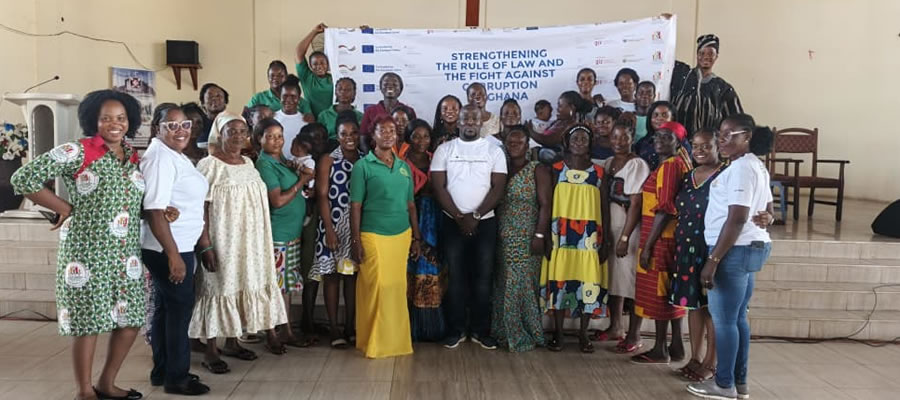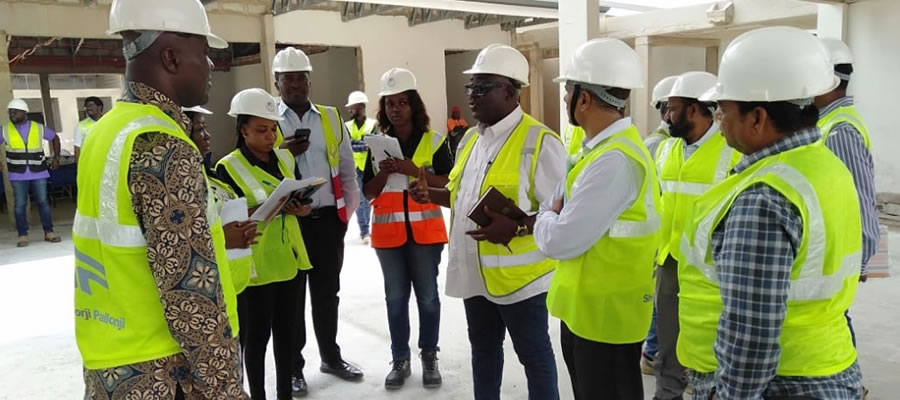

Background Information
The Shai Osudoku District is one of the sixteen (16) District Assemblies in the Greater Accra Region. It forms about 41.5% of the landmass of the Region and therefore the largest. The total land area is 1,442 sq km (144,201 ha), which consists of total cultivable land of 129,600 hectares and has a coastline stretch of about 37kms.
The District has 22km of the Lower Volta River running through and along the Northern to Eastern boundaries. About 45,600ha of the land is currently under cultivation with about 2,200 hectares under
irrigation.
The vegetation is mainly coastal savannah with a small transitional zone along the foothills of the Akwapim Range. The soil type is mainly of the heavy Akuse series with sandy and sandy-loams in certain areas. The rainfall pattern is bimodal and the main agricultural activities undertaken are livestock and crop production, fish production, fishing and fish processing and other agro-processing activities.
Crops production includes maize, cassava, rice, tomatoes, garden eggs, okra, pepper, watermelon, sugarcane, banana, pineapple, pawpaw and exotic vegetables (for export). Tree crops grown are mainly mangoes with a few small- scale cashew plantations in the Ningo area.
Livestock production comprise of cattle, sheep and goats with a large local poultry population, some medium scale holdings (ASAS, Sapporo Farms, Ratio Farms etc.) and few commercial holdings (e.g. Gateway (AAH) McBaron for Ostiches, Farmer George for broiler production etc.)
Fish production in inland waters is undertaken by Tropo Farms, a privately owned business enterprise and Aqua Agric, a development NGO with a few dams and dugouts being stocked with fish by the communities. Marine fishing and traditional fish processing are the main activity undertaken along the 37km stretch of coastline.
The District is also home to a prolific beekeeping activity that produces arguably the best honey in the country. The District, in spite of its proximity to the national capital is basically rural with a poor state of socio-economic and infrastructure development.
By virtue of its strategic location, that is the nearness to urban Accra and Tema which have the airport and sea port respectively and the Volta Lake Transport System that links the South to the North, the District has the potential to be converted into a preferred agribusiness destination. This we are determined to achieve in the near future.
The Agricultural Sector
The sector aims at establishing a modem robust and diversified agricultural sector that ensures national food security and an adequate supply of agricultural raw materials at competitive prices for industries and export.
The sector has over the years focused on:
- Improving production and incomes of farmers and other workers in agriculture
- Improving its contribution to GDP and Balance of payment.
- Increasing investor confidence.
OPERATIONAL ENVIRONMENT
District Development Goals
- Improve agricultural and industrial production and provide access to productivity and remunerative opportunities to earn income through employment and self-employment.
- Improve quality and increase access to social and economic infrastructure in the district.
- Develop human resource base of the district
- Develop the information, communication and database of the district.
- Encourage private sector participation in the development of the district
- Promote greater and local level participation in decision-making and to ensure sustainability of projects.
- Ensure sound environmental impact of the projects and to provide protection for restricted ecological areas.
- Improve the status of the vulnerable and disadvantaged in the district.
Ghana has a national goal to improve the standard of living and quality of life for all the citizenry. This is contained in the main policy document of the -GPRS. The sector is guided by the FASDEP - a framework that was developed from the tenets of the GPRS and in terms by the changing trends of agriculture in the country.
The FASDEP seeks the:
- Promotion of selected products through improved access to markets
- Development of, and improved access to technology for sustainable natural resource management
- Improved access to agricultural financial services
- Improved rural infrastructure
- Enhanced human resource and institutional capacity.
Despite the numerous handicaps confronting the district, it has come out with a plan of strategic development interventions to move agro-based industries forward. To increase wealth and improve on the standard of living of the District population
THE DISTRICT AGRIC DEVELOPMENT UNIT (DADU)
Functions
- All the District Agricultural activities are formulated and pursued with sensibility to gender concerns, eg backyard gardening for women, fish processing cassava processing etc
- The main business of the DADU is to provide the needed technical services, technology and measures that will improve the Agribusiness sector.
This is done through:
- Regular capacity building activities organised for both staff and farmers.
- Continuous collection and analysis of relevant data for planning purposes.
- Maintaining linkages with other relevant institutions like World Vision Ghana, Ghana Export Promotion Council, Animal Research Institute, FBOs, Community Development etc. which complement our activities.
- Facilitating fanners, fishermen and processors access to credit and market for efficient operation e.g. CBRDP, SIF, Shai and Dangme Rural Bank and Agricultural Development Bank.
AGRICULTURAL PRODUCTION
Major crops under cultivation
The viability of an agro processing industry for any of these crops could be high and without dispute.
Yield of Rice
Paddy yields have improved consistently from about 3tins/ha/crop before start of the project to 5.5tons/ha/crop representing a 83% change over the first year. This is largely as result of the introduction of quality seed and practices. Yields however range from 4.5 to 7.5 tons/ha/crop.
There is also growing a very lucrative business in vegetable Production for both the local and export markets. Commercial farmers are undertal iese in association with small-scale producer sunder nucleus/out grower arrangements.
The minimum size holding are 5ha. Some of the vegetable include chillies/pepper, okro, auberginer / ravaya, tinda etc. Other commercial farmers currently operating and making use of the KIP water supply system to grow maize, spices vegetables and fish include Tropo Farms Limited currently specializing in Tilapia production on a 13-ha fish tarm, Golden Exotics (Banana), S&M farms (Passion Fruit & Vegetable)
District Development Potentials
- The land size of 1,442 km2 has a total cultivable area of about 129,600 ha with a forest reserve of about 1,372 hectares located in Chipa, Fiakonya and Afienya and 45,600 ha under cultivation.
- The presence of about 20km stretch of the Volta River for irrigation, fresh water fishing andtransportation.
- A 37-kilometre stretch of coastal land along the Gulf of Guinea for tourism, fishing and salt Production.
- Presence of Game Reserves in the Shai Hills and Dodowa forest as tourist attraction sites.
- 32,400 ha of vast savannah land for livestock grazing
- Large livestock population, (Cattle-37, 685+, Sheep and Goat-11,000+
- Suitable climatic condition for the cultivation of wide range of crops (cereals, tubers, tree crops, vegetables and legumes). Mean annual rainfall is 762.5mm at the coast and 1220 mm in the Northeast. Temperatures (30-40°C) are high for most parts of the year with November-March being highest whiles July-August are the lowest.
- Establishment of exportable mango plantations are under cultivation of varieties like Keitt, Palmer, Springfield etc.Proximity to the National Capital provides Easy accessibility to the international market. Heavy fertile soils good for storing water for irrigation, aqua-cfulture and watering livestock.
Major Developmental Weakness
- Low level of infrastructure development
- Low capital base of farmers hence low levels of investment
- Subsistence agriculture (average 0.8 ha)
- Heavy soils that are difficult to till during the wet seasons.
- Over dependence on Rainfed Agriculture.
- Land fragmentations resulting from the existing land tenure system (private leasehold and family inheritance)
Major Opportunities
- Proximity to the Capital and the Market
- Possibility of all year round cultivation under irrigation
- Stable socio-cultural environment.
- Availability of agro by-products like rice straw and bran for livestock feeding.
- Good trunk roads facilitating movement.
- Readily available labour.
Major Threats
1. Fragmentation of land holdings
2. Lack of strong will to enforce the green belt or land use policy.
3. Mass out migration of economically active youth.
INVESTMENT OPPORTUNITIES
Livestock Production
Cattle, Sheep, Goats, Pigs, Grasscutter, Rabbit Ostrich, Guinea fowl. Ducks, Turkey etc.
Crops Production
Vegetables, (Exotic and Local), e.g., Tinder, Pepper, Banana, Pawpaw, Pumpkin Cassava, Mango, pineapple sunflower etc
Processing
Fruits and Vegetables (eg. Mango, Watermelon, Pineapple, Tomato, Pepper, Pawpaw Garden egg etc.) Cassava, Animal Products, and Sisal into fibre.
Production and Gainful Employment
The resource base of the district provides for a number of production systems. The most important are the ones for crop production, fisheries, livestock and industry.
Crop Farming
About 90 percent of the total land area is arable land but only 35 percent is presently under cultivation. Also, about 25 percent of the total land area is mainly savannah grassland that is suitable for livestock grazing.
Farming lands are acquired mainly through
• Inheritance or purchase
• Allocation by chiefs or family heads
• Lease
It is observed that the farmers who own land privately had no problems with ownership but in cases where land is allocated by chiefs or family heads, some sort of payment had to be made in the form of share cropping or fixed rent. The ratio of sharecropping is 2/3 for the tenant and 1/3 for the landlord. Still others pay a fixed amount as rent. On the whole, land acquisition is not a major problem in the District.
The average distance from homesteads to the farm plots is about 2.4 kilometres and the average farm size is 1.5 hectares.
Cropping Pattern
Farming is still predominantly subsistence oriented, except for tree crops. However, there is room for improvement in this sector in order to stimulate the development of the other sectors in the local economy. The cropping system is rotational bush fallow with fallow periods ranging from 2 to 4 years. This is gradually shifting to more permanent cropping system. The major crops grown in the district are cassava, maize, mango, banana, vegetables (for example, tomato, okro, pepper) and rice. Majority of the farmers practice mono cropping on a continuous basis for between 3 and 5 years. This naturally depletes the soil of its nutrients, hence, contributing to low productivity. Some farmers also practice mixed cropping.
Farm Labour
Farm labour sources are either household or hired labour. It is common practice for households to utilize more than one source of labour depending on the farming activity to be undertaken, size of the farm and the supply of labour. The cases where household members and other relatives are engaged, there is no clear cut payment except for food consumed. Hired labour is paid for in cash and in certain cases is made in kind. The amount spent on labour varies from one season to another in the same year depending on the demand and supply situation for hired labour for the respective farming activities. The most important problems related to farm labour are the high cost of labour and labour shortages especially experienced during land preparation, periods of weeding and harvesting.
Farm Inputs
Farmers in the district either use local seeds or purchase improved seeds from the open market. A proportion of the farmers cultivate both local and improved seeds. The knowledge about improved seeds may not be too widespread. Farmers complain that the cost of seeds is too high and sometimes not available on time for sowing. Some farmers in the district utilize industrial fertilizers whilst others use farmyard manure. Farmers generally report of high prices of fertilizers. Fertilizers are also sometimes not available on demand.
The commonest farm machinery available and in use is a medium sized tractor. The inadequate tractor services is one of the main problems encountered by farmers. In the rice growing areas farmers utilize a smaller tractor - the power tiller both to plough their fields and also to cart their produce from the farm to storage centres.
Farm Machinery
The Commonest farm machinery available and in use is a medium sized tractor. Seemingly, with the reduced dependence on the hoe especially for fairly large acreage, about 73 percent of the farmers use or hire tractors for ploughing of which 57.1 per cent have better access to them while 42.9 per cent complained of difficult accessibility due to the high demand for them during the periods of ploughing. A smaller tractor - Komota (power tiller) is used by 5.7 percent of the farmers mainly in the rice growing areas. It is also used for pulling carts and transportation of produce from farm to storage centres. Similarly, about half the number of farmers complain of difficult accessibility. About 41.3 per cent of farmers make use of spraying machines (privately owned or hired) in spraying their crops against pests and diseases.
Farming Finance
The most important sources of finance for farming activities are personal savings accounting for 67.3 per cent followed by relatives and friends (15.0 per cent). As much as 45.3 percent of the farmers expressed problems in acquiring finance to undertake farming activities. The problems identified were lack of adequate sources of credit in the district, insufficient personal savings and high interest rates charged by private moneylenders. In some cases where such credits existed, the money is not released on time thus affecting the promptness of undertaking a particular set of activities.
Pests and Disease
A variety of pests attack crops in the district. By far the major attacks are those caused by vertebrate pests, caterpillars and grasshoppers. Other pests include stem borers, locusts, termites, caterpillars, revealing that crop damage could reach alarming proportions if not properly controlled. As a result of the free range grazing system adopted by most livestock rearers, destruction of crops by cattle has also been identified as one of the major problems facing crop farmers in the district. The major diseases noted are blast on rice, wilts, anthracnose, rot, mildew and foliar deformations among others. These are mainly attributed to viral, fungi, bacteria and nutritional deficiencies. In cases of invertebrate pests and diseases infestation, the most important control measure is spraying with pesticides and fungicides. Other methods of control include bird scaring in rice fields and trapping for vertebrate pests. However, a small proportion of farmers do not employ any control measures mainly due to the high cost of pesticides.
Crop Production Levels in the District
The productivity output per hectare of the major crops grown in the district is presented. The table indicates that productivity per land area cultivated is very low except for rice; as compared to yields achievable nationally. This shows that much needs to be done to step up the level of agricultural productivity in the district.
Storage and Marketing of Produce
Perishable produce like tomato, garden eggs and cassava are sold immediately after harvest but other crops like pepper, maize and rice are sun-dried, stored and then sold later when prices are high as a result of increased demand. The most popular storage method in use is the traditional barn. This is followed by storage on rooftops. A small percentage of farmers on the irrigation project store their crops with the Irrigation Development Authority.
Extension Services
The district is divided into four agricultural zones and these are further sub-divided into nineteen operational areas. In all, the agricultural extension department has 37 extension personnel. The contact farmer method is the extension technique adopted by the departments. In executing this method, a member of the agricultural staff, mainly the technical officers visit his contact farmers who in turn visit other farmers. The group extension method is also used.
Irrigation
Irrigation agriculture is practiced on a medium scale in the District. About 15.6 percent of crop farmers are engaged in irrigation agriculture. This medium scale irrigated crop production has developed over the last 15-20 years in the Asutsuare area in the Volta River flood prone area. The Irrigation Development Authority (IDA) in collaboration with the communities runs the scheme.
The European Commission, The World Bank, The Food and Agriculture Organization and Japanese Government grants provide technical assistance. A smaller scheme is under operation at Dawhenya in the Southern Sector of the district. The irrigation project provides a pumping station (which lifts water from the Volta River) earthmoving machines and other tractors for land preparation, and a workshop as a service centre. The District Administration has supported the construction of another irrigation project at Tokpo on small scale to serve the farmers in the area.
The IDA thus provides mechanized services, extension services and water facilities for irrigation. The main produce of the farmers is rice with maize and vegetables as minor crops. Output levels are reasonably high. Average yields are around 38 bags per acre of cultivable land. Of the net irrigable area of 1,000 hectares at Asutsuare, approximately 800 hectares have been developed by 1991 and currently being worked by 580 (registered) farmers. In Dawhenya there is total farmland of 480 hectares out of which 240 hectares is currently under cultivation by 240 farmers
Livestock
There is generally a tendency for almost every household to keep a small number of livestock either as a dietary supplement or to be marketed to augment or supplement household income. There are two categories of livestock owners: pastoral farmers who undertake the rearing of animals as their main occupation and mixed farmers who also engaged in crop farming.
About 25 percent of arable land in the district, which is mainly savannah grassland, is suitable for livestock grazing. Currently the district has the greatest population of cattle in the Greater Accra Region.
In 1995, the Animal Research Institute of the Council for Scientific and Industrial Research and Heifer International, realizing the immense potentials of the District in livestock production, undertook an on-farm adaptive research at the Agortor Settlement Area. The study identified the settlement as a great potential for livestock production and made detailed recommendations towards the realization of this potential.
Majority of livestock stays continuously on natural grazing and browsing resources. An increasing number of non-browsing animals (mainly cattle and sheep) make use of by-products from crop cultivation. Generally, organized animal husbandry in Dangme-West could be made to meet with adequate feed requirements from the natural grazing land, rice bran from the irrigated rice fields and other grain resource
Fishing
The Shai Osudoku District borders on the Atlantic Ocean with a coastline stretching over 37 kilometers. The District therefore has a vast expanse offish potential. This potential is currently under great exploitation by some residents. The lower sections of the Volta river (and parts of the Volta Lake) also borders the northern reaches of the district and offers inland, fresh water fish potentials for the Shai Osudoku District. But the potential of the Volta River is currently lower compared to marine fishing in view of the construction of the Akosombo and the Kpong Dams upstream which has negatively affected catch.
There is however a big potential for aquaculture (Fish farming), which is currently being exploited by a foreign investor, Tropo Farms Ltd at Asutsuare. The Volta, however, remains cool and oxygenated, flowing throughout the year. Fishing is one of the major economic activities in the district. Its importance is evident by the considerable concentration of small-scale fish related industries, especially fish smoking, in notable areas such as Prampram, Lekpongunor, Dodowa and Ahwiam - the second largest catch area of marine fish in the Greater Accra Region.
Fishing in the district is an all round activity but with two main identifiable seasons namely the peak season usually around July-August, and the lean season. The District chose aqua culture as a priority project under the Rural Enterprise Development Project and currently sinking cages at Kasunya area to improve upon aqua culture in the District. The major inputs used in fishing are boats or canoes (dug-out) and oars, nets, outboard motors hooks and traps. Fishing gear is thus more sophisticated and their costs are very high.
Date Created : 11/24/2017 4:08:36 AM












 facebook
facebook
 twitter
twitter
 Youtube
Youtube
 +233 593 831 280
+233 593 831 280 0800 430 430
0800 430 430 GPS: GE-231-4383
GPS: GE-231-4383 info@ghanadistricts.com
info@ghanadistricts.com Box GP1044, Accra, Ghana
Box GP1044, Accra, Ghana